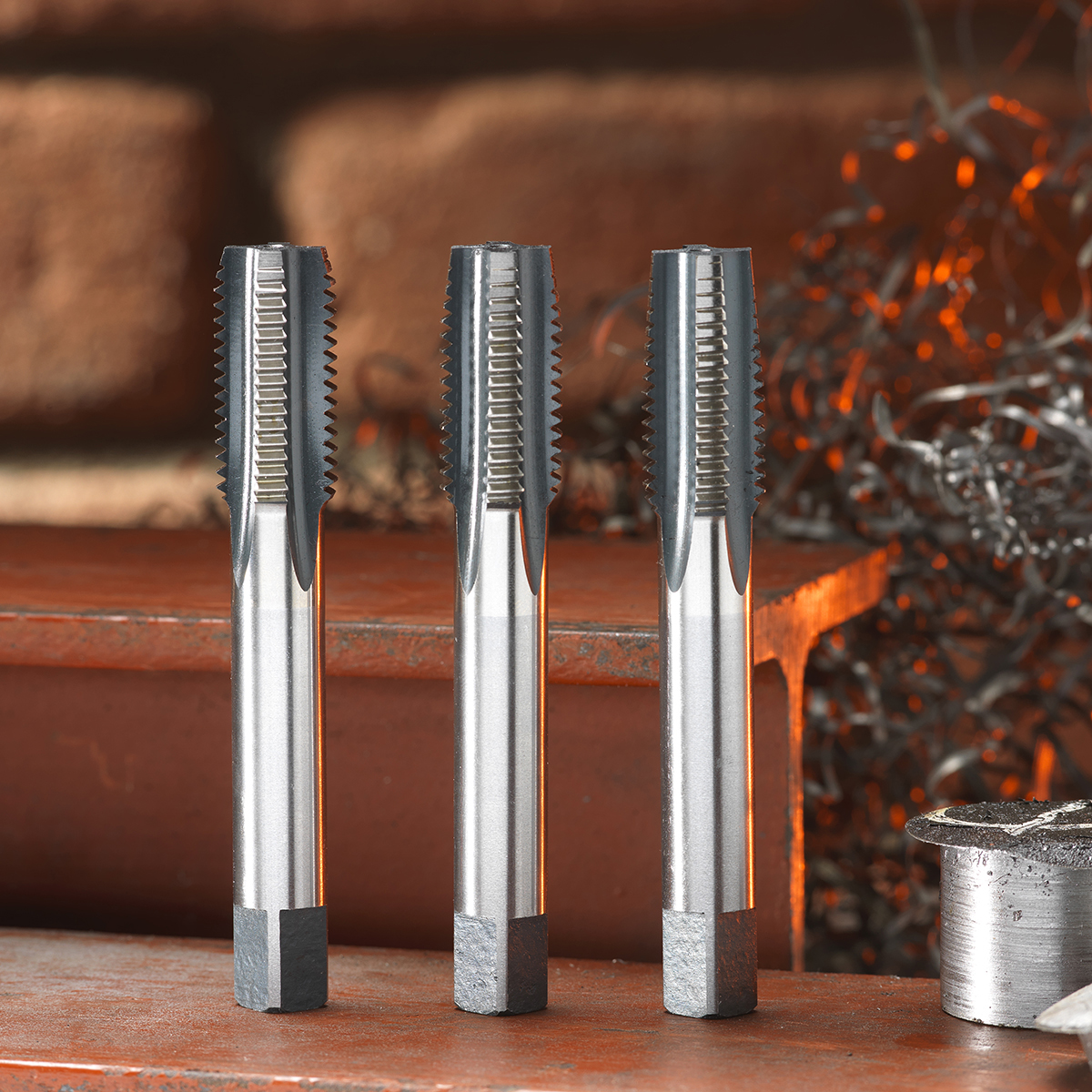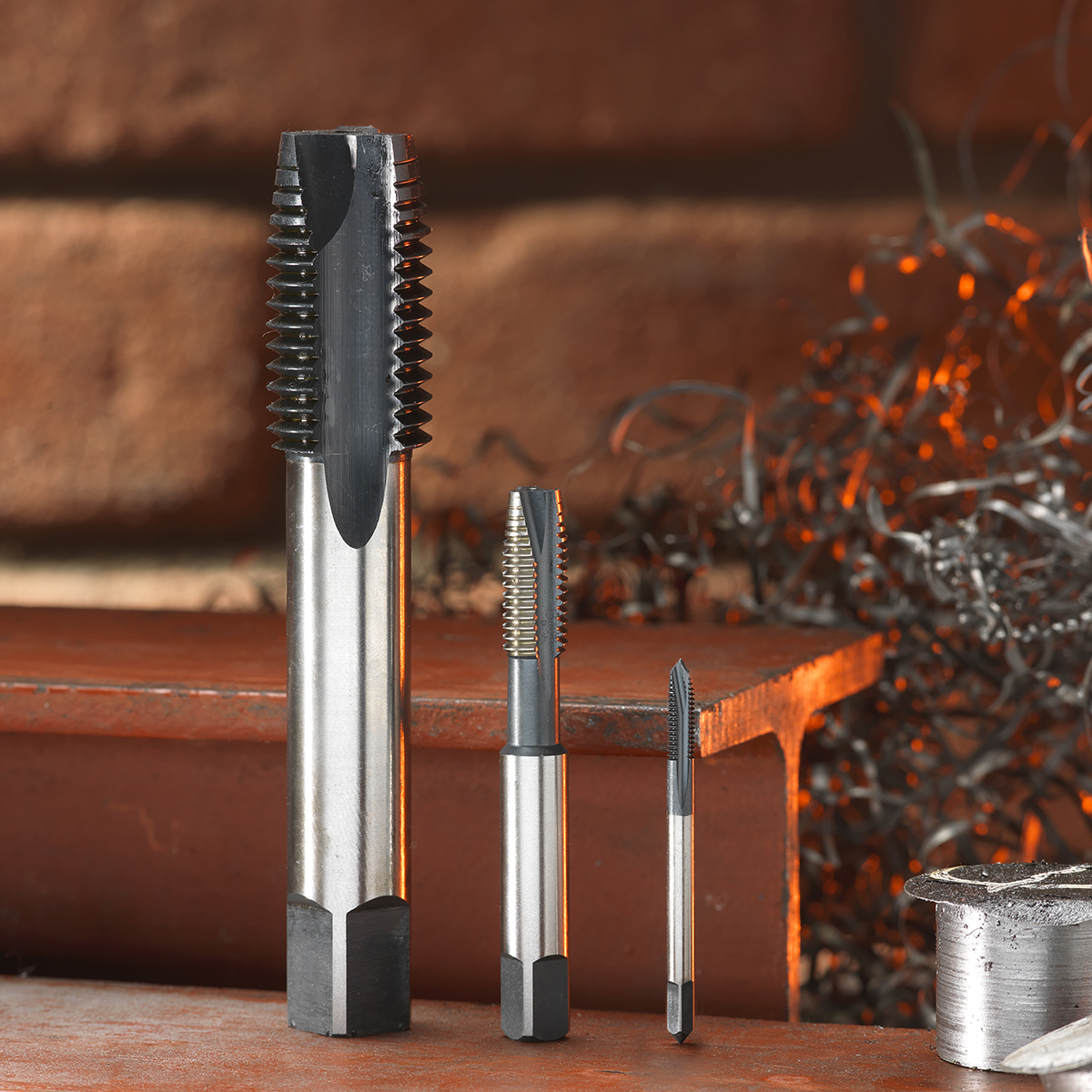

Metal tapping
An essential part of metal fabrication, tapping is crucial to producing quality goods in a range of different industries. Here are some frequently asked questions about tapping.
What is tapping?
Metal tapping is a technique used in metalworking and sheet metal fabrication that involves using a tool, called a tap, to create a straight threaded hole in a piece of metal for a screw or bolt. The tap is a specialized tool which features cutting teeth on its end, used to cut threads into the metal as the tap is rotated. This technique is commonly used to create threads in holes that have been drilled into metal parts, allowing them to be fastened together using screws or bolts. Metal tapping is an important process in the manufacturing of many metal products, such as cars, appliances, and machinery.

How thick should metal be to tap?
The thickness of the metal work piece will determine the size of the tap that can be used to create threads in the metal. Generally speaking, the thicker the metal, the larger the tap that can be used. However, the size of the tap required will depend on: the type of metal, the type of threads being cut, and the specific application for which the threads are being created. It is important to use the correct size tap for the job to ensure that the threads are cut properly and that the finished product is strong and durable.
What are the 3 types of taps?
There are several different types of taps, but the three most common types are:
- Taper taps, which are tapered at the end and are used to start threading.
- Plug taps, which are similar to taper taps but have a more gradual taper and are used for general purpose threading.
- Bottoming taps, which have a very slight taper and are used for cutting threads all the way to the bottom of a blind hole.
These three types of taps are used in different applications and are selected based on the specific needs of the project. For example, a taper tap might be used to create threads in a hole that has not been fully drilled, while a plug tap might be used for general purpose threading, and a bottoming tap might be used to create threads all the way to the bottom of a blind hole.

How do I choose the right tap for metal tapping?
Choosing the right tap for metalworking depends on a few factors, including the type of metal you are working with, the size and depth of the hole you need to thread, and the type of thread you need to create. Here are some guidelines to help you choose the right tap:
- Identify the type of metal you will be working with. Different metals have different properties and may require different types of taps to thread effectively. For example, softer metals like aluminum may require a different tap than harder metals like steel.
- Determine the size of the hole you need to thread. Taps come in a range of sizes, and it is important to choose one that is the right size for the hole you are working with. If the tap is too small, it may not be able to cut threads effectively, and if it is too large, it may not fit in the hole properly.
- Consider the type of thread you need to create. Taps are designed to create different types of threads, such as Unified National Coarse (UNC), Unified National Fine (UNF), or Metric threads. Choose a tap that is designed to create the type of thread you need.
- Select a tap with the appropriate number of flutes. Taps typically have either 2 or 3 flutes, which are the cutting teeth on the tap. A tap with 2 flutes is generally better for softer metals, while a tap with 3 flutes is better for harder metals.
- Consider the material and coating of the tap. Taps can be made of different materials, such as high-speed steel or cobalt, and can have different coatings, such as titanium nitride, to improve their durability and cutting ability. Choose a tap that is appropriate for the type of metal you are working with and the conditions in which you will be using it.
What can I use a tap with?
Taps can be used with both handheld options and machine tools, hand taps are used manually for smaller jobs, whereas other taps can be designed to fit into the chuck of a mag drill, allowing the tip to cut through metal efficiently on an industrial scale, producing minimal debris under careful operation. If a drill has forward/backwards functionality, like the Element 100, it is ideal for tapping metal for a screw.
What are first tap, second tap, intermediate tap, plug tap and taper tap referring to?
A first tap and second tap refer to the two different taps that are typically used in the process of creating threaded holes in metal. The first tap, also known as the taper tap, is used to create a tapered opening at the beginning of the hole. This tap has a slightly larger diameter than the finished thread size, and it is used to ease the cutting process and prevent the tap from becoming stuck in the hole.
The second tap, also known as the plug tap or intermediate tap, is used to create the majority of the threads in the hole. This tap has a diameter that is the same as the finished thread size, and it is used to create the threads to the desired depth.
The third tap, also known as the bottoming tap or finishing tap, is used to complete the threading process. This tap has a shorter, chamfered end that allows it to thread the bottom of the hole without digging into the bottom of the hole. It is typically used to create threads in a hole that has been drilled all the way through a piece of metal.
In some cases, only a first and second tap may be used, with the second tap serving both the intermediate and finishing functions. It is important to choose the right combination of taps for your specific application to ensure that the threads are created properly and the hole is properly threaded.

Can you tap aluminium?
Yes, it is possible to tap aluminum. Tapping, or the process of creating threads in a hole, can be done on aluminum as well as many other types of metals. However, tapping aluminum does require special considerations and techniques.
Aluminum is a relatively soft metal, and it can be prone to tearing and deformation when tapped. This can result in threads that are damaged or incomplete, and can make it difficult to install fasteners securely. To tap aluminum effectively, it is important to use the right tools and techniques, such as using a lubricant to reduce friction and heat, and using taps with a higher number of flutes to improve cutting ability.
It is also important to choose the right tap for the specific type of aluminum you are working with. Aluminium alloys can have different properties and may require different tapping methods and tools.
What are tapping tools made from?
Tapping tools, also known as taps, are typically made from high-speed steel (HSS) or cobalt. High-speed steel is a strong and durable material that is commonly used for making cutting tools, such as drills and taps. It is able to withstand high temperatures and maintain its cutting ability, making it well suited for use in metalworking applications.
Cobalt is another common material used for making tapping tools. It is a high-performance material that is able to maintain its cutting ability at even higher temperatures than high-speed steel. This makes it ideal for use in applications where there is a risk of the tap overheating, such as when tapping hard metals or when using high cutting speeds.
In addition to the material used to make the tap, the cutting teeth on the end of the tap may also be coated with a hard, wear-resistant material, such as titanium nitride. This can improve the tap’s durability and cutting ability, and can help to extend its lifespan.
Overall, the choice of material for a tapping tool will depend on the specific application and the type of metal being worked on.
What is tapping fluid?
Tapping fluid, also known as tap lubricant or cutting oil, is a special type of lubricant that is used when tapping metal. It is applied to the tap and the workpiece to reduce friction and heat, and to improve the cutting ability of the tap.
Tapping fluid typically contains a mixture of lubricating oils and other additives, such as extreme pressure (EP) agents and anti-weld agents. The lubricating oils help to reduce friction and heat, while the EP agents improve the tap’s ability to cut through metal, and the anti-weld agents prevent the tap from sticking to the metal and tearing the threads.
Tapping fluid is an important tool in the metalworking process, as it helps to improve the quality and consistency of the threads being created. It is especially useful when tapping harder metals, or when using high cutting speeds, as it can help to prevent the tap from overheating and becoming damaged.
Tapping fluid is typically applied to the tap and the workpiece using a brush or a spray. It is important to apply the tapping fluid regularly and consistently during the tapping process to ensure that the tap is able to cut effectively and efficiently.
No Related Posts